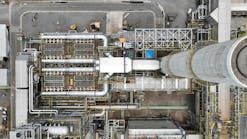California Bay Area advances plan for enhanced refinery regulations
California’s Bay Area Air Quality Management District (BAAQMD), the public agency responsible for regulating stationary sources of air pollution in the nine counties that surround San Francisco Bay, is moving forward with its plan to impose further emissions cuts on area refiners within the next 5 years.
BAAQMD’s board of directors unanimously voted on Dec. 17 to adopt the proposed emissions reduction strategy, which sets a goal of reducing refinery emissions by 20%, or as much as feasible, by 2020.
Adoption of the heightened emissions-control strategy follows BAAQMD’s October resolution (OGJ Online, Oct. 21, 2014) directing its staff to determine the best way to decrease emissions from area refineries by evaluating a range of approaches against a variety of factors such as reductions of “criteria pollutants” (pollutants for which air quality standards have been established), toxics, and greenhouse gases (GHGs), as well as impacts on neighboring communities, the agency said in a statement.
“Our new refinery emissions reduction strategy continues and reaffirms [BAAQMD’s] commitment to significantly decrease harmful air pollution in our communities,” said Jack Broadbent, BAAQMD’s executive officer.
“This strategy will ensure that refineries are taking the strongest steps to cut emissions and minimize their health impacts on neighboring residents and the region as a whole,” according to Broadbent.
Implementation of the emissions reduction strategy will involve ongoing work with community and industry participants during 2015 to develop and refine a package of proposed associated rules, BAAQMD said.
As part of the approved strategy, the agency said it will continue preparation of its proposed Petroleum Refining Emissions Tracking Rule (PRET), which would require refiners to provide updated health risk assessments (HRAs), install additional fence-line and neighborhood monitoring capacity, and compile annual emission inventories.
Preparation of a “companion rule” to PRET also remains under way, according to BAAQMD.
Earlier billed by the industry as another iteration of the “baseline rule” removed from a previous draft version of PRET amid a series of legal challenges under California law, the proposed “companion rule” would set emissions thresholds as well as mitigate potential emissions increases from area refineries.
The agency plans to present a final set of proposed rules to BAAQMD’s board of directors sometime in 2015.
While Bay Area’s five refiners plan to continue actively collaborating with BAAQMD on its emissions-reduction strategy, the agency’s goals may be a bit too ambitious within the proposed timeframe, according to the Western States Petroleum Association (WSPA).
“The Bay Area refineries will constructively participate in the strategy's rule making,” Guy Bjerke, WSPA’s Bay Area region manager, told OGJ.
“Our main concern with the strategy is the 20% reduction by 2020 goal which, given historic reductions over the past 10 years, are likely unachievable and impractical in just 5 years,” Bjerke said.
BAAQMD’s proposed strategy
To achieve its overall goal of a 20% emissions reduction from refineries alongside a 20% reduction in health risks to local communities over the next 5 years, the proposed strategy includes the following components:
• Reduction of criteria pollutants. Under a focused best available retrofit control technology (BARCT) program, BAAQMD will investigate significant sources at refineries and pursue a variety of additional pollution controls at these sources. Rulemaking is already underway to reduce sulfur dioxide from coke calciners and particulate matter from catalytic cracking units. Several other rules to reduce refinery emissions also will be developed in 2015.
• Reduction of health risks from toxic air pollution. This approach will begin with requirements to reduce toxic emissions from key refinery sources such as cooling towers and coking units. The focused toxics approach will also include site-wide HRAs and the identification of sources for further emission controls, using health benefits as an important evaluative tool.
• Evaluation of GHG emissions. Under this approach, BAAQMD would track emission reductions at refineries incurred as a result of the cap-and-trade system under California’s AB 32 climate law, which requires the state to reduce its GHG emissions to 1990 levels by 2020. Refinery performance would be compared to third-party standards for best practices, with analysis of potential further opportunities for reductions.
• Continuous improvement. To ensure continuous improvement in emission reductions, refiners will be required to periodically evaluate the sources of the majority of their emissions in order to determine if additional pollution controls are needed.
BAAQMD previously acknowledged that overall emissions from the region’s five refineries, which already are subject to more than 20 specific agency regulations and programs, have been steadily decreasing.
